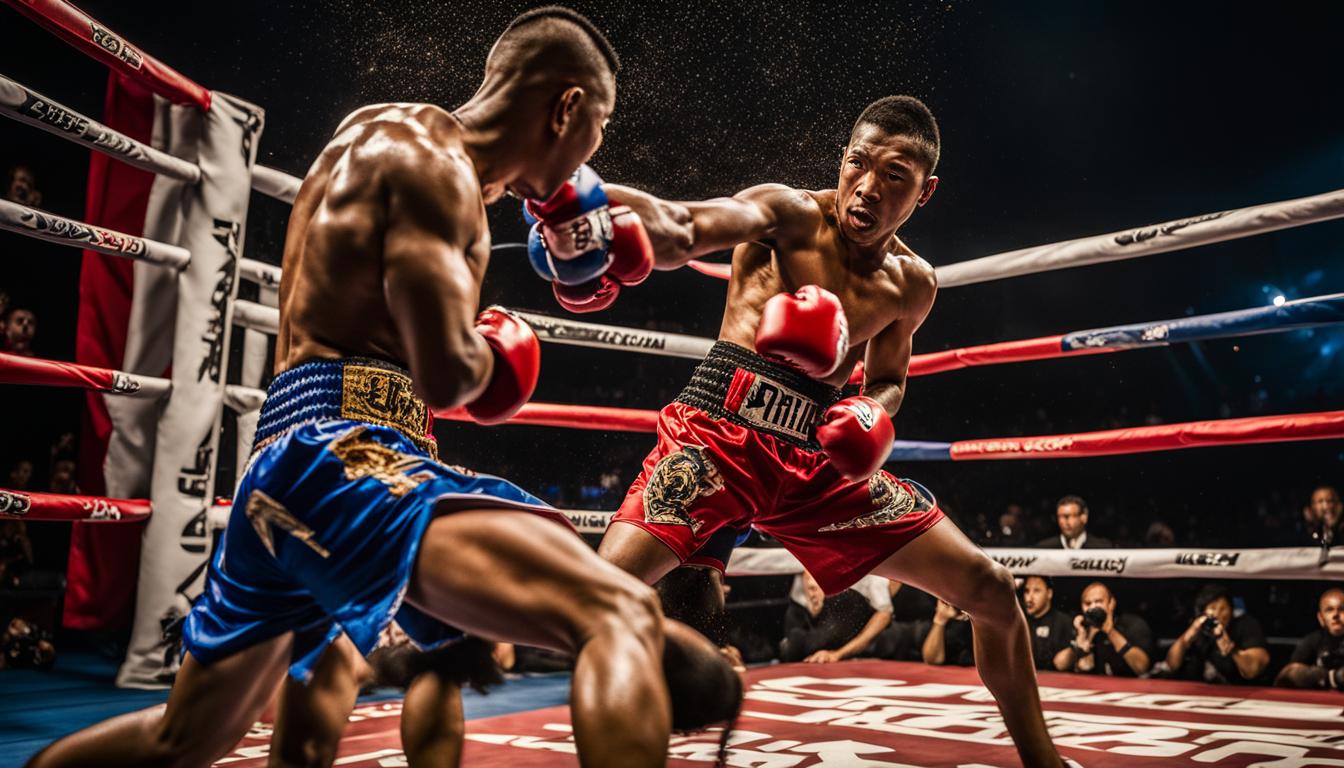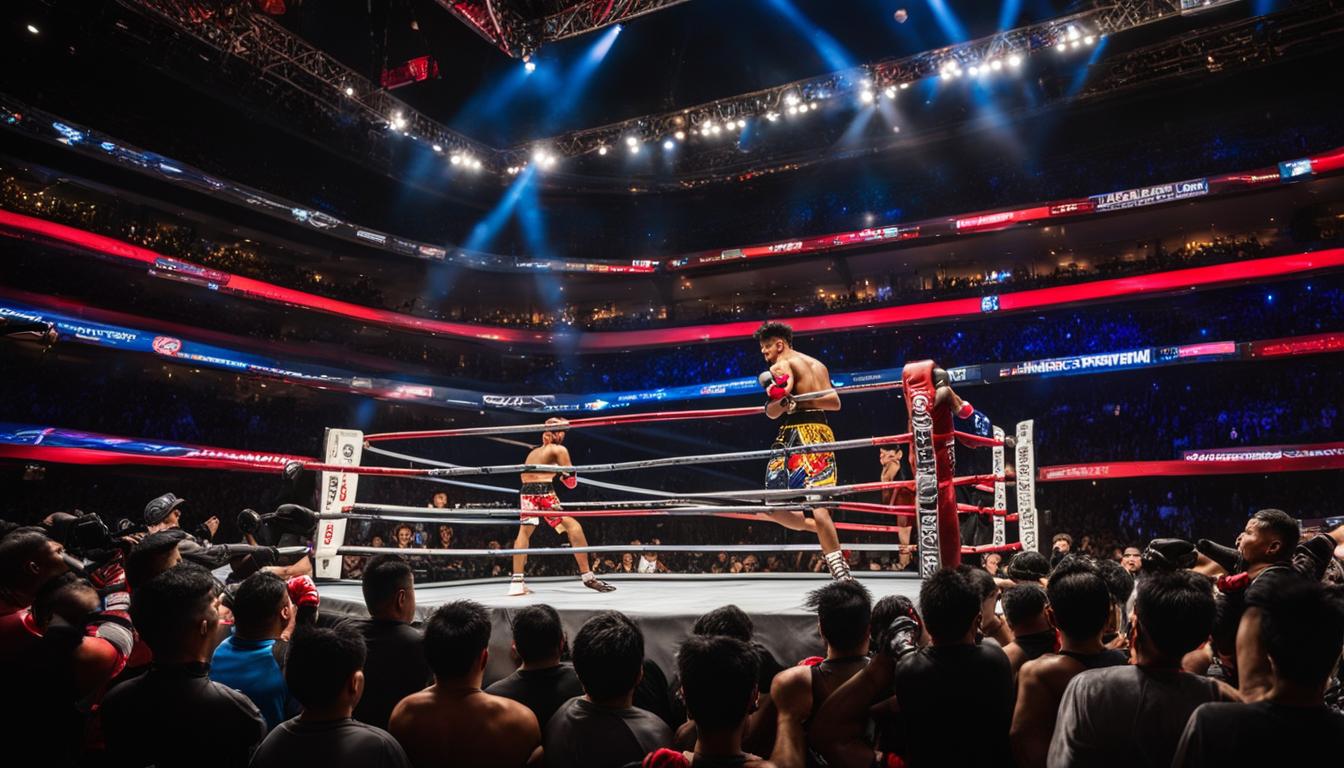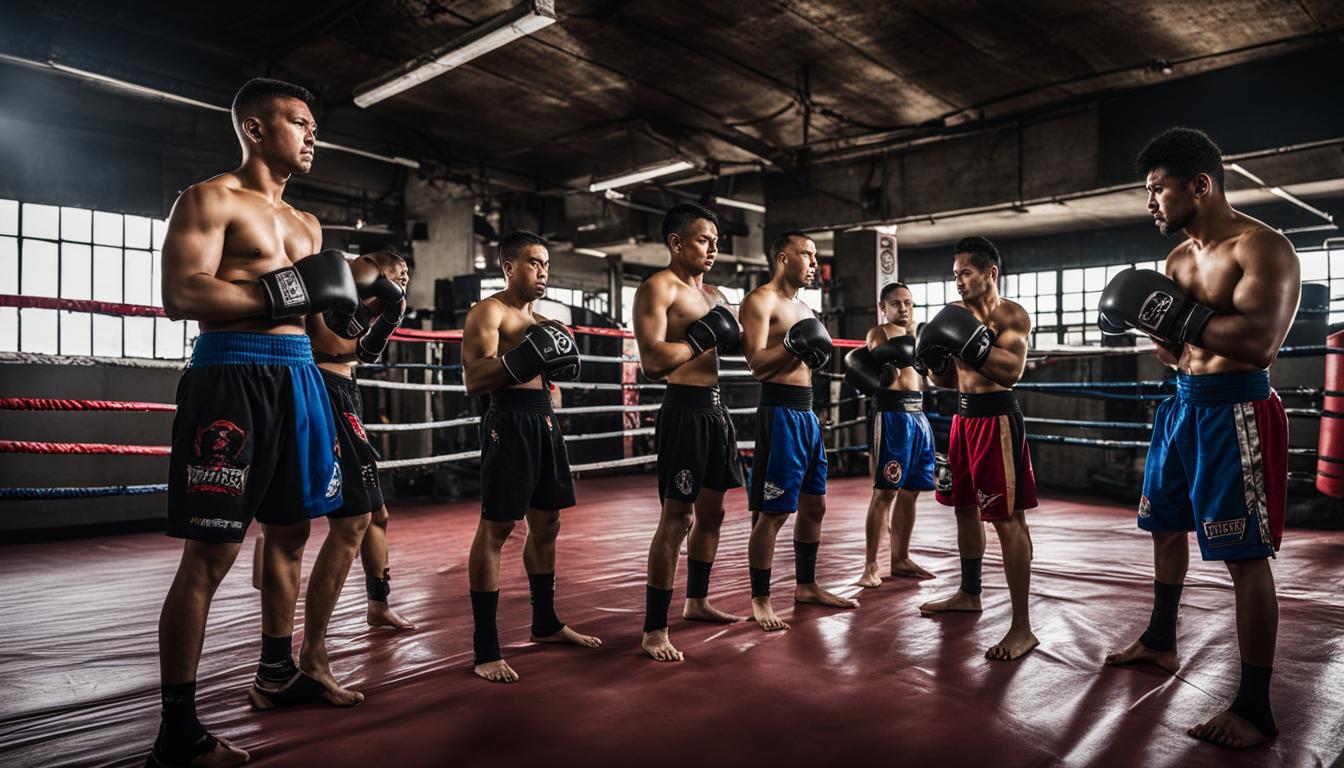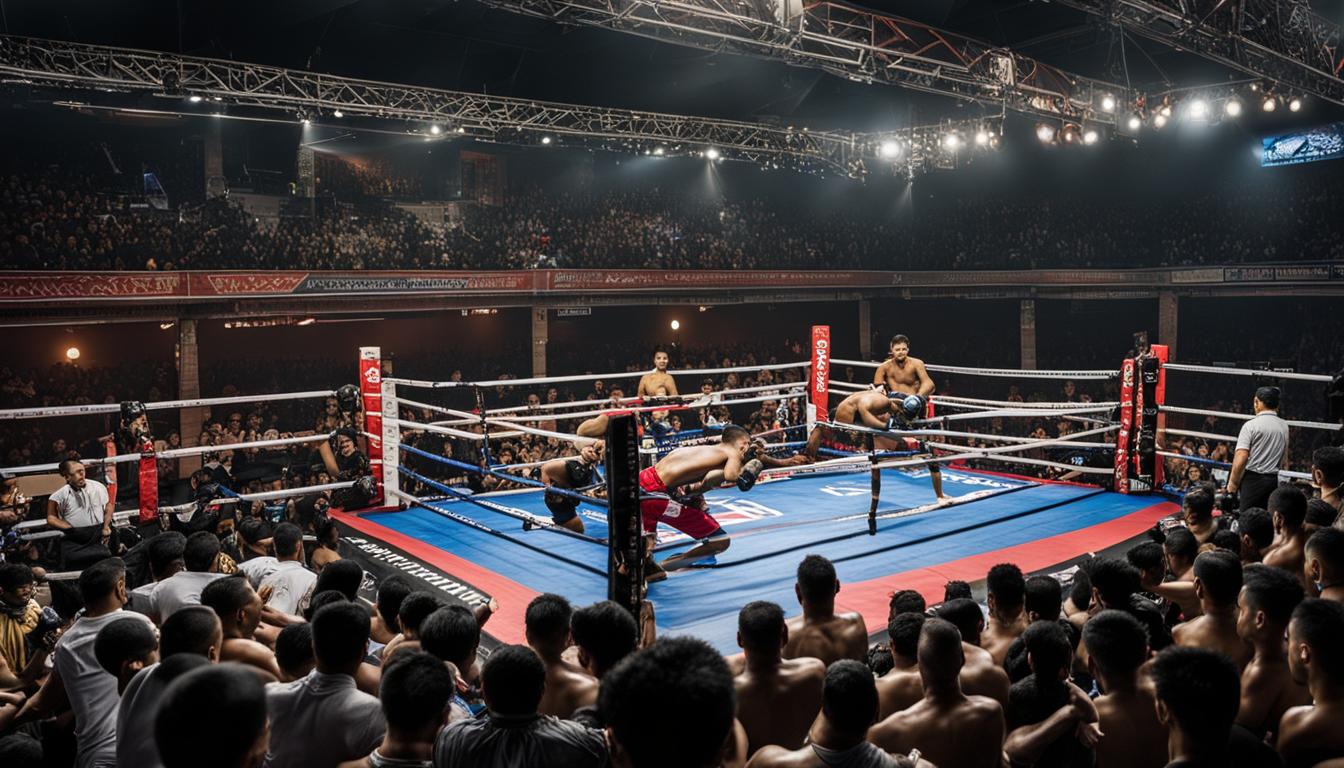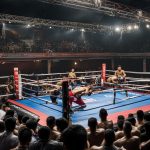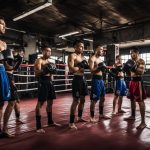Muay Thai fights, also known as the “Art of Eight Limbs,” are a thrilling combat sport that combines the use of fists, elbows, knees, and legs. It is widely regarded as the most effective striking discipline in the world. The sport carries profound cultural significance in Thailand, where it is the national sport. Muay Thai fights are known for their discipline, respect, and honor. In this guide, we will explore the world of Muay Thai fights, from the techniques and training to the exciting events and championships that showcase the best fighters in the sport.
Key Takeaways:
- Muay Thai fights are a thrilling and effective combat sport.
- Muay Thai is the national sport of Thailand.
- The sport emphasizes discipline, respect, and honor.
- Techniques and training are crucial for success in Muay Thai fights.
- Exciting events and championships showcase the best fighters in the sport.
The Basics: Stance And Footwork
One of the fundamental aspects of Muay Thai is the stance and footwork. Having a strong and balanced stance is crucial for executing techniques effectively. The proper positioning of the feet and body allows fighters to generate power and maintain stability. Footwork plays a vital role in movement and allows fighters to create angles and evade strikes. Training in Muay Thai techniques and finding a reputable Muay Thai gym are essential for mastering the basics of the sport.
In Muay Thai, the fighter’s stance is characterized by a square and slightly bladed position. This allows for maximum stability and power generation. The lead foot should be turned slightly outward, while the rear foot remains planted firmly on the ground. The weight is distributed evenly between both legs, ensuring balance and mobility. The hands are kept up, guarding the face, with the elbows tucked in to protect the body.
Footwork in Muay Thai is dynamic and strategic. Fighters utilize various movements to create angles and maintain distance from their opponents. Some common footwork techniques include the shuffle, pivot, and step-slide. These movements help fighters to create openings for attacks, evade strikes, and control the pace of the fight. Footwork is honed through consistent training and practice, enabling fighters to move fluidly and effectively in the ring.
| Fundamental Aspects | Stance | Footwork |
|---|---|---|
| Importance | Crucial for executing techniques effectively | Allows for movement and evading strikes |
| Key Points | – Square and slightly bladed position, with lead foot turned slightly outward – Weight evenly distributed between both legs – Hands up, guarding the face, and elbows tucked in |
– Dynamic and strategic movements – Shuffle, pivot, and step-slide techniques – Create angles and maintain distance |
| Training | Reputable Muay Thai gym | Consistent practice and training |
Mastering the basics of Muay Thai begins with understanding and developing a strong stance and effective footwork. By finding a reputable Muay Thai gym and engaging in regular training, fighters can enhance their technique, power, and mobility. With proper positioning and dynamic footwork, fighters can execute strikes and maneuvers with precision and efficiency, setting the foundation for success in the world of Muay Thai.
Mastering the Strikes: Punches, Kicks, Knees, and Elbows
When it comes to Muay Thai fights, mastering the strikes is essential for any fighter looking to excel in the sport. Muay Thai utilizes a variety of strikes, including punches, kicks, knees, and elbows, each with its own technique and purpose. These strikes are not only effective but also showcase the power and versatility of Muay Thai as a combat discipline.
One of the primary striking techniques in Muay Thai is the punch. Punches are used to set up combinations and create openings for other strikes. Learning the proper technique, such as maintaining a solid stance and generating power from the hips and shoulders, is crucial for executing punches effectively.
Another integral part of Muay Thai strikes is the use of kicks. With a focus on using the entire body as a weapon, Muay Thai kicks deliver devastating blows. Techniques such as the roundhouse kick, push kick, and head kick require proper form, balance, and timing to maximize their impact.
Close-quarter combat is where Muay Thai truly shines, and the use of knees and elbows highlight this aspect of the sport. Knees are a powerful weapon in the clinch, allowing fighters to deliver significant damage to their opponents. Elbows, often called the “swords of Muay Thai,” are highly effective in close-range combat, capable of causing devastating cuts and knockouts.
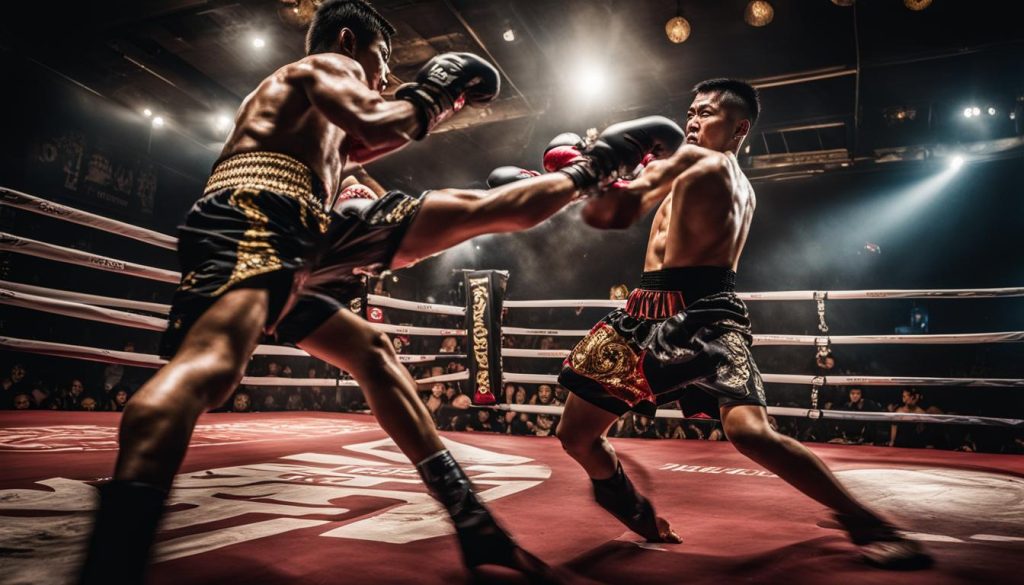
Table: Comparison of Muay Thai Strikes
| Strike | Technique | Purpose |
|---|---|---|
| Punches | Straight punches, hooks, uppercuts | Set up combinations and create openings |
| Kicks | Roundhouse kick, push kick, head kick | Deliver devastating blows and keep opponents at a distance |
| Knees | Clinch and deliver powerful strikes | Inflict significant damage and disrupt opponents’ balance |
| Elbows | Close-quarters strikes with various angles | Cause cuts, knockouts, and intimidate opponents |
Mastering these strikes requires extensive training and practice in Muay Thai techniques. Developing proper form, power, and precision are essential to execute these strikes effectively in the ring. By dedicating time and effort to training, fighters can become proficient in the art of striking in Muay Thai and elevate their overall performance in fights and championships.
The Clinch: Close-Range Combat
Muay Thai fights are renowned for their intensity and diversity of combat techniques. One crucial aspect that sets Muay Thai apart from other martial arts is the clinch, a close-range combat position that allows fighters to control their opponents and launch devastating strikes. In the clinch, fighters can effectively utilize their elbows, knees, and sweeps to gain an advantage over their opponents.
Training in the clinch is essential for any aspiring Muay Thai fighter. It requires a high level of technique, balance, and strength. During clinch training sessions, fighters learn how to establish a secure grip on their opponent’s neck or arms while maintaining their own defensive posture. They also practice a variety of strikes and sweeps that can be executed from the clinch position.
Muay Thai events often showcase the skill and intensity of fighters in the clinch. Spectators witness the strategic battle for control, as fighters aim to deliver devastating strikes while avoiding their opponent’s attacks. The clinch adds a layer of excitement and unpredictability to Muay Thai fights, as it can quickly turn the tide of a match and lead to a dramatic finish.
| Benefits of Clinch Training: |
|---|
| Gaining control over opponents |
| Enhancing close-range striking techniques |
| Improving balance and strength |
| Developing effective defensive techniques |
Defense and Counter-Attacks
Effective defense is essential in Muay Thai fights. Fighters must possess the skills to block and evade strikes while maintaining their balance and composure. A strong defense allows fighters to withstand their opponent’s attacks and create opportunities for counter-attacks, potentially changing the course of the fight. Training in defensive techniques is a crucial aspect of Muay Thai training. It teaches fighters how to protect themselves and respond effectively to their opponent’s strikes.
Defensive techniques in Muay Thai include blocking, parrying, and slipping. Blocking involves using the arms and shins to absorb the impact of strikes, minimizing the damage inflicted. Parrying is the act of redirecting an opponent’s strike away from its intended target. It requires precise timing and coordination. Slipping involves moving the head and upper body to avoid incoming strikes. This subtle movement allows fighters to evade blows and create openings for counter-attacks.
Counter-attacks are an integral part of defense in Muay Thai. When executed correctly, a well-timed counter-attack can catch an opponent off guard and potentially lead to a knockout. Fighters must be trained to recognize their opponent’s openings and react swiftly with precise strikes. Counter-attacks can include punches, kicks, knees, or elbows, depending on the situation. The ability to efficiently defend and counter-attack requires practice, timing, and a deep understanding of Muay Thai techniques.
| Defensive Technique | Description |
|---|---|
| Blocking | Using arms and shins to absorb the impact of strikes. |
| Parrying | Redirecting an opponent’s strike away from its intended target. |
| Slipping | Moving the head and upper body to avoid incoming strikes. |
Mastering defense and counter-attacks in Muay Thai is a continuous process. It requires constant practice, refinement of techniques, and the ability to adapt to different fighting styles. By honing their defensive skills and developing effective counter-attacks, fighters can become formidable opponents in Muay Thai fights, capable of defending themselves while inflicting damage on their opponents.
The Importance of Defense
Defense is often underrated in combat sports, but in Muay Thai, it is a crucial aspect that separates champions from the rest. A strong defense allows fighters to withstand the relentless attacks of their opponents and minimize the damage they receive. By effectively blocking, parrying, and slipping strikes, fighters can maintain their stamina and mental clarity throughout the fight.
“A good offense wins fights, but a good defense wins championships.” – Unknown
Counter-attacks in Muay Thai are not just about retaliating; they are about capitalizing on the opponent’s weaknesses. By carefully observing their opponent’s movements and reactions, fighters can identify openings and launch devastating counter-attacks that catch their opponents off guard. These counter-attacks can quickly turn the tide of the fight and lead to a knockout victory.
In conclusion, defense and counter-attacks are vital components of Muay Thai. A strong defense allows fighters to weather their opponent’s storm, while well-executed counter-attacks can lead to decisive victories. Through disciplined training and relentless practice, fighters can develop the skills necessary to defend themselves effectively and seize opportunities to launch devastating counter-attacks, ensuring their success in the ring.
Different Styles in Muay Thai
Muay Thai is a dynamic combat sport that allows fighters to showcase their individual styles and techniques. Each fighter brings a unique set of skills and strategies to the ring, creating a captivating and diverse spectacle for spectators. From powerful strikers to elusive counter-attackers, the best Muay Thai fighters have honed their craft and developed their own distinct fighting styles.
Professional Muay Thai fights are a testament to the variety of styles within the sport. Some fighters prioritize aggression and explosive power, relying on devastating strikes to overwhelm their opponents. These fighters often have a strong background in boxing or kickboxing, which contributes to their technique and knockout potential. Examples of fighters known for their powerful strikes include Buakaw Banchamek and Yodsanklai Fairtex.
On the other hand, there are fighters who excel in evasiveness and counter-attacks. These fighters are adept at dodging their opponents’ strikes and capitalizing on openings with precise and devastating counters. Their style requires excellent footwork, agility, and timing. Saenchai, one of the most legendary and skilled Muay Thai fighters, is known for his elusive and unpredictable style.
Table: Styles of Professional Muay Thai Fighters
| Style | Description | Notable Fighters |
|---|---|---|
| Power Striker | Relies on explosive strikes to overpower opponents | Buakaw Banchamek, Yodsanklai Fairtex |
| Counter-Attacker | Evasive and capitalizes on opponent’s openings | Saenchai, Sam-A Gaiyanghadao |
| Technician | Focuses on technical precision and strategy | Ramon Dekkers, Liam Harrison |
| Clinch Specialist | Masters the clinching techniques for close-range combat | Saenchai, Petchboonchu F.A. Group |
There are also fighters who employ a technical and strategic approach. These fighters prioritize precision and strategy, carefully selecting their strikes and tactics based on their opponent’s weaknesses. They often excel in reading their opponents’ movements and exploiting their vulnerabilities. Renowned fighters like Ramon Dekkers and Liam Harrison exemplify this technical style of fighting.
The clinch is another area where fighters can showcase their style and expertise. Some fighters specialize in the clinch, utilizing close-range techniques such as knee strikes, sweeps, and off-balancing techniques to dominate their opponents. Saenchai and Petchboonchu F.A. Group are known for their exceptional clinching skills, allowing them to control their opponents and deliver devastating strikes in close-quarters combat.
Whether a fighter’s style is characterized by power, evasiveness, technical precision, or clinch mastery, the best Muay Thai fighters have cultivated their own unique approaches to the sport. Observing the diversity and skill of different fighters in professional Muay Thai fights is an enlightening and inspiring experience, showcasing the artistry and versatility of this captivating combat sport.
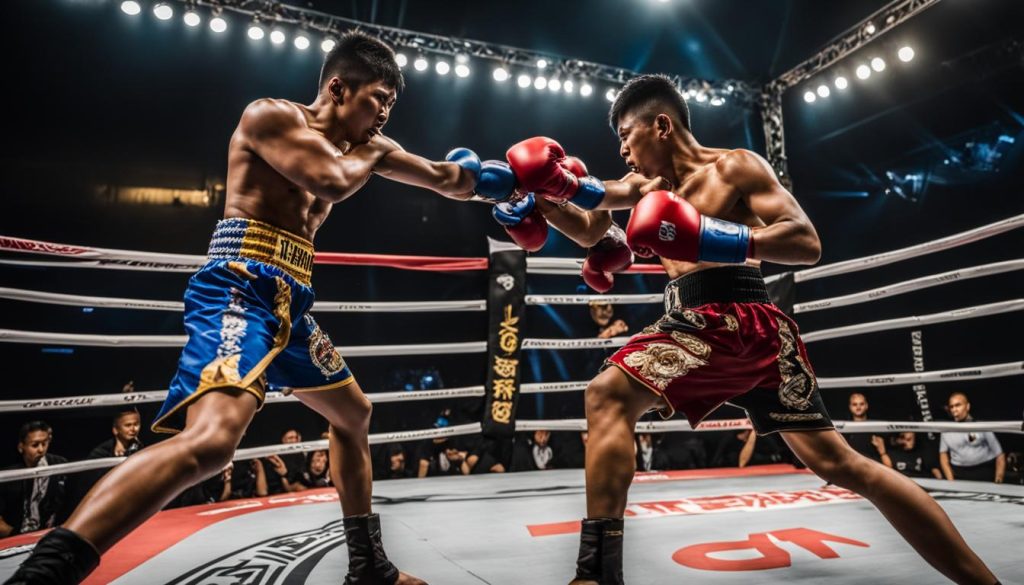
Rules and Scoring in Muay Thai
Muay Thai fights adhere to specific rules and a scoring system that ensure fair competition and uphold the integrity of the sport. Understanding these rules and scoring criteria is essential for both fighters and spectators to fully appreciate the intricacies and excitement of Muay Thai matches.
When it comes to scoring in Muay Thai, judges assess several factors to determine the winner of a fight. Fighters earn points for effective strikes, technique, dominance, and ring control. The judges also take into account elements such as aggression, defense, and sportsmanship. Knockouts and knockdowns carry significant weight in the scoring process, as they often demonstrate the superiority and impact of a fighter’s skills.
Table: Scoring Criteria in Muay Thai
| Scoring Criteria | Description |
|---|---|
| Effective Strikes | Successful strikes that land on the opponent and show control and accuracy. |
| Technique | The demonstration of proper Muay Thai technique in executing strikes, clinches, and defensive maneuvers. |
| Dominance | Establishing control over the opponent, both in terms of scoring and dictating the pace and flow of the fight. |
| Ring Control | Maintaining control of the fighting area and strategically positioning oneself to gain an advantage. |
| Knockouts and Knockdowns | Strikes that result in the opponent being knocked down or knocked out. |
It’s important to note that Muay Thai fights are judged as a whole, considering all rounds and the overall performance of each fighter. This means that a fighter who dominates some rounds but performs poorly in others may not necessarily be the winner. The judges assess the cumulative performance throughout the entire match to determine the final result.
In addition to the established scoring system, Muay Thai fights also have specific rules that govern the conduct of the fighters. These rules ensure the safety of the competitors and maintain fair competition. Some of the common rules include no strikes below the belt, no strikes to the groin, no striking the back of the head, no biting, and no eye gouging. Violation of these rules can lead to penalties or disqualification.
Training Regimen for Muay Thai
Training in Muay Thai requires a structured regimen that focuses on building strength, endurance, and technique. Fighters undergo rigorous training sessions to prepare themselves physically and mentally for the demands of the sport. A well-rounded training program typically includes a combination of cardio exercises, strength training, pad work, sparring, and conditioning drills.
Cardio exercises play a crucial role in improving cardiovascular endurance, which is essential for the high-intensity nature of Muay Thai fights. Running, skipping, and cycling are commonly incorporated into training routines to enhance stamina and overall fitness levels.
Strength training exercises help fighters develop power and explosiveness in their strikes. This may include weightlifting, bodyweight exercises, and resistance training. Building strength in the core, legs, and upper body is particularly important for generating force in punches, kicks, and clinch techniques.
Pad work and sparring sessions allow fighters to practice their techniques with a partner, honing their precision, timing, and reflexes. This hands-on training is essential for improving striking accuracy, defensive skills, and overall fight strategy.
Sample Training Regimen:
| Training Component | Duration | Frequency |
|---|---|---|
| Cardiovascular Endurance | 30-60 minutes | 3-5 times per week |
| Strength Training | 45-60 minutes | 2-3 times per week |
| Pad Work/Sparring | 60-90 minutes | 2-3 times per week |
| Conditioning Drills | 30-45 minutes | 3-4 times per week |
Consistency and dedication to training are key to becoming a proficient Muay Thai fighter. It is important to work closely with experienced trainers at a reputable Muay Thai gym who can provide guidance, correct techniques, and push you beyond your limits. Remember, Muay Thai training is not just about physical conditioning; it also fosters mental discipline and a strong sense of self-confidence.
Training in Muay Thai requires discipline, commitment, and an unwavering focus. It is a sport that demands both physical and mental strength. The training regimen encompasses various aspects, from cardiovascular endurance to strength building and technique refinement. Muay Thai fighters must push their limits in every training session to develop the skills necessary to succeed in the ring. At the heart of it all lies the dedication to constant improvement and the pursuit of excellence.
Choosing the Right Muay Thai Gym
When it comes to training in Muay Thai, choosing the right gym is essential. It sets the foundation for your growth as a fighter and can significantly impact your progress. With so many options available, it’s important to consider a few key factors that will help you make an informed decision.
Expertise and Experience of Trainers
The expertise and experience of the trainers at a Muay Thai gym play a crucial role in your development as a fighter. Look for a gym that has experienced instructors who can provide you with proper guidance and coaching. Ask about their background in Muay Thai and their track record of training successful fighters. A knowledgeable and skilled trainer can help you refine your technique, improve your skills, and guide you towards achieving your goals.
Facilities and Equipment
The facilities and equipment available at a gym are also important considerations. A well-equipped gym with a variety of training gear will allow you to train effectively and efficiently. Look for gyms that have a dedicated training area, a range of punching bags, pads for practicing strikes, and a suitable area for sparring. Additionally, check if the gym has amenities such as showers and changing rooms to ensure a comfortable training experience.
Training Atmosphere and Gym Reputation
The training atmosphere and gym reputation are factors that can greatly impact your overall experience. Visit different gyms and observe their training sessions to get a feel for the atmosphere. Look for a gym that promotes a positive and supportive environment, where fighters encourage and motivate each other. Additionally, consider the gym’s reputation within the Muay Thai community. Ask other fighters or do some research online to get an idea of the gym’s standing and track record.
Conclusion
Muay Thai fights, also known as the “Art of Eight Limbs,” captivate audiences with their electrifying displays of technique, skill, and discipline. From beginners venturing into the world of Muay Thai to seasoned fighters aspiring for championship glory, this combat sport offers endless opportunities for growth and excitement. By mastering the techniques, training diligently, and immersing oneself in the culture of Muay Thai, fighters can experience the energy and thrill that only this sport can provide.
With its profound cultural significance in Thailand as the national sport, Muay Thai fights have become a globally recognized showcase of power, dexterity, and sportsmanship. The championships, where the best fighters in the sport compete, draw in enthusiasts and spectators from all corners of the world. Witnessing the high-intensity battles unfold in the ring is a testament to the dedication and skill required to excel in Muay Thai.
Whether you’re eager to step into the ring or simply an admirer of the sport, Muay Thai offers an unforgettable journey. The combination of techniques, training, and the indomitable spirit of the fighters ensures that each encounter is a testament to the artistry and power of Muay Thai. So, embrace the essence of Muay Thai, seek out the best gyms, and prepare to be captivated by the thrilling world of Muay Thai fights and championships.
FAQ
What is Muay Thai?
Muay Thai, also known as the “Art of Eight Limbs,” is a combat sport that combines the use of fists, elbows, knees, and legs. It is widely regarded as the most effective striking discipline in the world.
What is the significance of Muay Thai in Thailand?
Muay Thai is the national sport of Thailand and holds profound cultural significance in the country.
What are the fundamental aspects of Muay Thai?
The fundamental aspects of Muay Thai include the stance, footwork, strikes, clinching, defense, and training regimen.
What are the different strikes used in Muay Thai?
Muay Thai fighters use punches, kicks, knees, and elbows in their strikes.
What is the clinch in Muay Thai?
The clinch is a close-range combat technique that allows fighters to control their opponents and deliver strikes using elbows, knees, and sweeps.
How important is defense in Muay Thai?
Defense is crucial in Muay Thai fights as fighters must be able to block, evade, and counter-attack their opponents’ strikes.
Can fighters develop their own fighting styles in Muay Thai?
Yes, fighters can develop their own unique fighting styles based on their strengths and preferences.
How are Muay Thai fights scored?
Muay Thai fights are scored based on effective strikes, technique, dominance, and ring control. Knockouts and knockdowns also play a significant role in scoring.
What does training in Muay Thai involve?
Training in Muay Thai involves a structured regimen that focuses on building strength, endurance, and technique through cardio exercises, strength training, pad work, sparring, and conditioning drills.
How do I choose the right Muay Thai gym?
When selecting a Muay Thai gym, factors to consider include the expertise of the trainers, available facilities and equipment, training atmosphere, and the gym’s reputation.
Source Links
- https://evolve-mma.com/blog/the-complete-muay-thai-beginners-guide/
- https://www.reddit.com/r/MuayThai/comments/3xak0u/first_fight_in_depth_write_up_on_my_experience/
- https://www.fodors.com/world/asia/thailand/experiences/news/what-its-like-to-train-at-a-muay-thai-fighting-camp
muay thai training for everyone
Last modified: December 1, 2023

